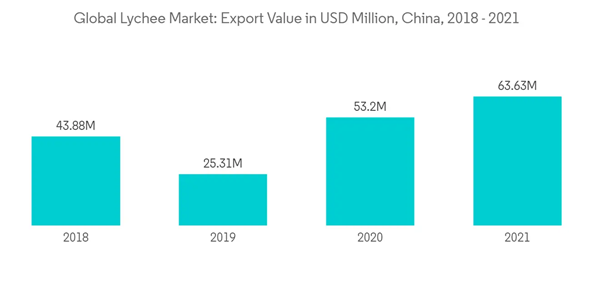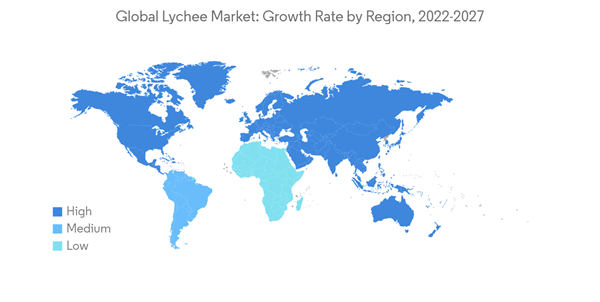The Lychee Market size is estimated at USD 7.10 billion in 2024, and is expected to reach USD 9.27 billion by 2029, growing at a CAGR of 5.5% during the forecast period (2024-2029).
The rising demand for lychee in France and other EU countries is expected to boost lychee imports further in the coming years. Thus, the demand for lychee in many countries is increasing tremendously with each passing year. The exports to international markets, along with domestic consumption, are expected to grow during the forecast period.
Lychee is becoming more popular in the perfume, skin care, and hair care industries, as well as in the cosmetics and fragrances industries.The growing HORECA industry in the United States, which serves continental food, is driving up demand for the fruit.The lychee fruit is now finding its way into supermarkets across Canada. The majority of the consumption is based on importing the fruit from neighboring countries and Asian countries. Litchis are consumed in salads, ice creams, custards, and other desserts by the Canadian population.
China is the leading exporter of lychee fruit. The country had exported lychee fruit worth USD 63.3 million in 2021, with the main destinations being Hong Kong, Singapore, the United States, Indonesia, the Philippines, and Malaysia.
Lychee is one of the prominent fruits grown in India. In India, the government and private companies have been taking initiatives to boost value addition, exports, and the value realization of farmers. For instance, in 2020, Coca-Cola India, DeHaat, the National Research Center on Litchi (NRCL), and Kedia's fresh partner launched an initiative called Unnati Litchi. The initiative is aimed at enhancing the efficiency of the agri-value chain and farmers' capabilities by building on high-density plantations, farmer training for good agriculture practices (GAP), and the creation of demo orchards through appropriate technology interventions. Thus, the aforementioned factors are driving the market, which is anticipated to grow during the forecast period.
According to horticulture statistics, the area of cultivation under lychee was 96,000 hectares in 2019. Similarly, lychee production was at 686,450.0 metric tons in 2017, and it increased to 720,980.0 metric tons by 2021. Directorate General of Commercial Intelligence and Statistics (DGCIS) says that Nepal, the United Arab Emirates, the United Kingdom, and Bhutan are the top places where India sends lychee.The export quantity increased by almost 80% from 2017 and reached 193.8 metric tons in 2021.
The Agricultural and Rural Department of Guangdong Province says that Guangdong, which has more than one-third of the world's planting area, will have a big harvest in 2020. The exports increased substantially. By June 2020, the Guangdong province exported around 4,000 metric tons of lychee, leading to a 20% year-on-year increase. Based on the figures from ITC TradeMap, the total export value of lychee from China in 2020 was USD 53.19 million, which increased by almost 20%, reaching USD 63.6 million in 2021. The major importing countries from China are Hong Kong, Singapore, Indonesia, and the Philippines. China's exports to Hong Kong and Singapore in 2021 will be significantly higher than in 2017. In 2017, the export value from Singapore was USD 0.34 million, and it rose to USD 7.6 million in 2021.
This product will be delivered within 2 business days.
Key Highlights
- The market for lychee is growing because people in emerging and developing countries around the world want more fresh food.Favorable government initiatives and rising trade from the significant producers drive the market's growth. The need for products like jam, juice concentrates, canned lychee, dried lychee, etc. is also increasing. At the end of 2019, Vietnam entered an agreement with lychee farmers to export lychees to Japan.
- China is a major producer and exporter of lychees, with a large share of the world market for lychee exports.According to the ITC Trade Map, the total fresh lychee export from China was worth USD 63.6.2 million in 2021. Neighboring Asian countries and the United States are China's major markets for lychee exports. European consumers consider lychee a 'sweet, nutritious' super fruit, which also drives the large volume of lychee exports to countries like the Netherlands and the United Kingdom.
- The export of lychee has considerably increased over the years, mainly because of the increasing demand for healthy food in these markets. According to data from the General Administration of Customs of China (GACC), Guangdong province exported 5,902.1 metric tons of lychee in 2020, showing an increase of 72.3% in comparison to 2019.
- Lychee production is mostly in the Asia-Pacific region. China, Vietnam, India, Taiwan, and other Southeast Asian countries are the main countries that make lychees. Lychee from Madagascar occupies a strong position in the European market. Hence, the rising demand and favorable government support are expected to significantly boost market growth in the coming years.
Lychee Market Trends
Increasing Demand from International Markets
Consumers are becoming more aware of health issues and conscious about their diet. Lychees are well known for being healthy fruits. Lychee is a specialty fruit that is slowly gaining popularity in Europe, although average consumption per capita is still limited. The fruit is gaining popularity in France as well. Consumption of sustainably produced fresh fruit offers greater opportunity in Europe.The rising demand for lychee in France and other EU countries is expected to boost lychee imports further in the coming years. Thus, the demand for lychee in many countries is increasing tremendously with each passing year. The exports to international markets, along with domestic consumption, are expected to grow during the forecast period.
Lychee is becoming more popular in the perfume, skin care, and hair care industries, as well as in the cosmetics and fragrances industries.The growing HORECA industry in the United States, which serves continental food, is driving up demand for the fruit.The lychee fruit is now finding its way into supermarkets across Canada. The majority of the consumption is based on importing the fruit from neighboring countries and Asian countries. Litchis are consumed in salads, ice creams, custards, and other desserts by the Canadian population.
China is the leading exporter of lychee fruit. The country had exported lychee fruit worth USD 63.3 million in 2021, with the main destinations being Hong Kong, Singapore, the United States, Indonesia, the Philippines, and Malaysia.
Expanding Lychee Market in the Asia-Pacific Region
Lychee is primarily produced in China and India. China is the main producer of lychees, followed by India and other countries in Southeast Asia. According to the International Society for Horticultural Science (ISHS), in 2019, Southeast Asian countries accounted for 19% of the lychee market. Madagascar accounted for 35% of the global exports, followed by Vietnam and China with 19% and 18%, respectively.Lychee is one of the prominent fruits grown in India. In India, the government and private companies have been taking initiatives to boost value addition, exports, and the value realization of farmers. For instance, in 2020, Coca-Cola India, DeHaat, the National Research Center on Litchi (NRCL), and Kedia's fresh partner launched an initiative called Unnati Litchi. The initiative is aimed at enhancing the efficiency of the agri-value chain and farmers' capabilities by building on high-density plantations, farmer training for good agriculture practices (GAP), and the creation of demo orchards through appropriate technology interventions. Thus, the aforementioned factors are driving the market, which is anticipated to grow during the forecast period.
According to horticulture statistics, the area of cultivation under lychee was 96,000 hectares in 2019. Similarly, lychee production was at 686,450.0 metric tons in 2017, and it increased to 720,980.0 metric tons by 2021. Directorate General of Commercial Intelligence and Statistics (DGCIS) says that Nepal, the United Arab Emirates, the United Kingdom, and Bhutan are the top places where India sends lychee.The export quantity increased by almost 80% from 2017 and reached 193.8 metric tons in 2021.
The Agricultural and Rural Department of Guangdong Province says that Guangdong, which has more than one-third of the world's planting area, will have a big harvest in 2020. The exports increased substantially. By June 2020, the Guangdong province exported around 4,000 metric tons of lychee, leading to a 20% year-on-year increase. Based on the figures from ITC TradeMap, the total export value of lychee from China in 2020 was USD 53.19 million, which increased by almost 20%, reaching USD 63.6 million in 2021. The major importing countries from China are Hong Kong, Singapore, Indonesia, and the Philippines. China's exports to Hong Kong and Singapore in 2021 will be significantly higher than in 2017. In 2017, the export value from Singapore was USD 0.34 million, and it rose to USD 7.6 million in 2021.
Additional Benefits:
- The market estimate (ME) sheet in Excel format
- 3 months of analyst support
This product will be delivered within 2 business days.
Table of Contents
1 INTRODUCTION
4 MARKET DYNAMICS
5 MARKET SEGMENTATION (Production Analysis, Consumption Analysis, Import Market Analysis by Value and Volume, Export Market Analysis by Value and Volume, and Price Trend Analysis)
Methodology

LOADING...










